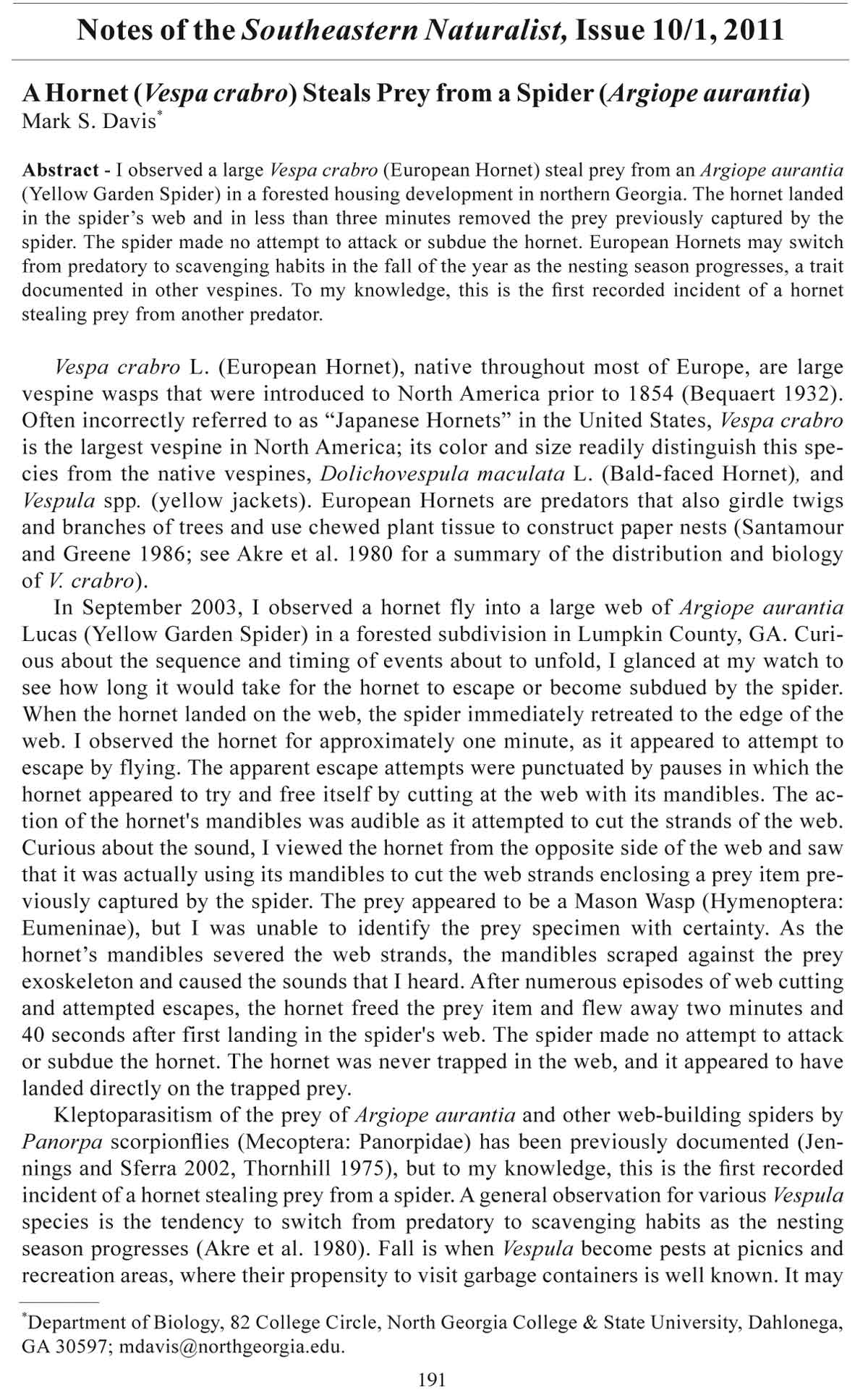A Hornet (Vespa crabro) Steals Prey from a Spider (Argiope aurantia)
Mark S. Davis*
Abstract - I observed a large Vespa crabro (European Hornet) steal prey from an Argiope aurantia
(Yellow Garden Spider) in a forested housing development in northern Georgia. The hornet landed
in the spider’s web and in less than three minutes removed the prey previously captured by the
spider. The spider made no attempt to attack or subdue the hornet. European Hornets may switch
from predatory to scavenging habits in the fall of the year as the nesting season progresses, a trait
documented in other vespines. To my knowledge, this is the first recorded incident of a hornet
stealing prey from another predator.
Vespa crabro L. (European Hornet), native throughout most of Europe, are large
vespine wasps that were introduced to North America prior to 1854 (Bequaert 1932).
Often incorrectly referred to as “Japanese Hornets” in the United States, Vespa crabro
is the largest vespine in North America; its color and size readily distinguish this species
from the native vespines, Dolichovespula maculata L. (Bald-faced Hornet), and
Vespula spp. (yellow jackets). European Hornets are predators that also girdle twigs
and branches of trees and use chewed plant tissue to construct paper nests (Santamour
and Greene 1986; see Akre et al. 1980 for a summary of the distribution and biology
of V. crabro).
In September 2003, I observed a hornet fly into a large web of Argiope aurantia
Lucas (Yellow Garden Spider) in a forested subdivision in Lumpkin County, GA. Curious
about the sequence and timing of events about to unfold, I glanced at my watch to
see how long it would take for the hornet to escape or become subdued by the spider.
When the hornet landed on the web, the spider immediately retreated to the edge of the
web. I observed the hornet for approximately one minute, as it appeared to attempt to
escape by flying. The apparent escape attempts were punctuated by pauses in which the
hornet appeared to try and free itself by cutting at the web with its mandibles. The action
of the hornet's mandibles was audible as it attempted to cut the strands of the web.
Curious about the sound, I viewed the hornet from the opposite side of the web and saw
that it was actually using its mandibles to cut the web strands enclosing a prey item previously
captured by the spider. The prey appeared to be a Mason Wasp (Hymenoptera:
Eumeninae), but I was unable to identify the prey specimen with certainty. As the
hornet’s mandibles severed the web strands, the mandibles scraped against the prey
exoskeleton and caused the sounds that I heard. After numerous episodes of web cutting
and attempted escapes, the hornet freed the prey item and flew away two minutes and
40 seconds after first landing in the spider's web. The spider made no attempt to attack
or subdue the hornet. The hornet was never trapped in the web, and it appeared to have
landed directly on the trapped prey.
Kleptoparasitism of the prey of Argiope aurantia and other web-building spiders by
Panorpa scorpionflies (Mecoptera: Panorpidae) has been previously documented (Jennings
and Sferra 2002, Thornhill 1975), but to my knowledge, this is the first recorded
incident of a hornet stealing prey from a spider. A general observation for various Vespula
species is the tendency to switch from predatory to scavenging habits as the nesting
season progresses (Akre et al. 1980). Fall is when Vespula become pests at picnics and
recreation areas, where their propensity to visit garbage containers is well known. It may
*Department of Biology, 82 College Circle, North Georgia College & State University, Dahlonega,
GA 30597; mdavis@northgeorgia.edu.
Notes of the Southeastern Nat u ral ist, Issue 10/1, 2011
191
192 Southeastern Naturalist Vol. 10, No. X
be that Vespa crabro workers undergo a similar switch, and spider webs could be reliable
foraging sites for scavenging in undisturbed forested habitats. Argiope spiders have been
shown to respond differently to different prey items in terms of biting and wrapping behavior
(Harwood 1974, Robinson 1969). European Hornets are large wasps, and spiders
may be reluctant to challenge such potentially formidable opponents.
Acknowledgments. I thank Robert Matthews, James Costa, and two anonymous reviewers
for reading the manuscript and providing helpful suggestions.
Literature Cited
Akre, R.D., A Greene, J.F. MacDonald, P.J. Landolt, and H.G. Davis. 1980. The Yellowjackets
of America North of Mexico. US Department of Agriculture, Washington, DC. Agricultural
Handbook No. 552. 102 pp.
Bequaert, J. 1932. A tentative synopsis of the hornets and yellow-jackets (Vespinae: Hymenoptera)
of America. Entomologica Americana, N.S. 12:71–138.
Harwood, R.H. 1974. Predatory behavior of Argiope aurantia (Lucas). American Midland Naturalist
91(1):130–139.
Jennings, D.T., and N.J. Sferra. 2002. An arthropod predator-prey kleptoparasite association.
Northeastern Naturalist 9(3):325–330.
Robinson, M.H. 1969. Predatory behavior of Argiope argentata (Fabricius). American Zoologist
9(1):161–173.
Santamour, F.S., Jr., and A. Green. 1986. European Hornet damage to ash and birch trees. Journal
of Arboriculture 12(11):273–279.
Thornhill, R. 1975. Scorpionflies as kleptoparasites of web-building spiders. Nature 258:709–711.














 The Southeastern Naturalist is a peer-reviewed journal that covers all aspects of natural history within the southeastern United States. We welcome research articles, summary review papers, and observational notes.
The Southeastern Naturalist is a peer-reviewed journal that covers all aspects of natural history within the southeastern United States. We welcome research articles, summary review papers, and observational notes.